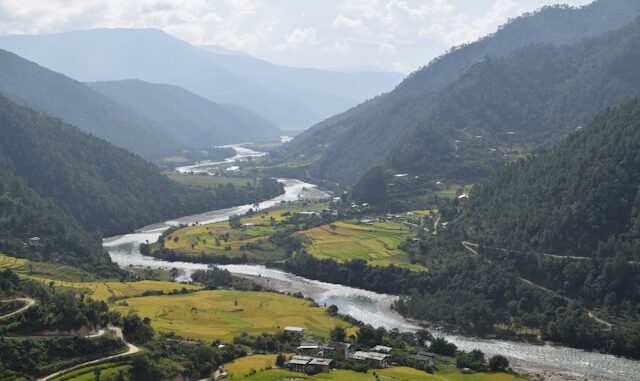
Nestled in the eastern Himalayas, Bhutan is a pristine sanctuary of natural beauty, culture, and ecological harmony. Revered as one of the last true wildernesses on Earth, Bhutan has zealously protected its environment, resulting in flourishing ecosystems, biodiverse forests, and untouched mountain ranges that captivate the hearts of nature enthusiasts around the globe.
Bhutan’s Unique Environmental Philosophy: Gross National Happiness Meets Conservation
What sets Bhutan apart is its national philosophy of Gross National Happiness (GNH), which places a significant emphasis on environmental conservation. This approach has allowed Bhutan to remain carbon negative, with over 70% of its land area covered in forests. These forests act as a carbon sink, absorbing more carbon dioxide than the nation emits. Bhutan’s Constitution mandates a minimum of 60% forest cover at all times, ensuring future generations inherit a green and thriving nation.
Diverse Flora and Fauna: A Biodiversity Hotspot
Bhutan is recognized globally as a biodiversity hotspot, sheltering more than 5,400 species of plants, including over 300 medicinal plants and a staggering variety of rhododendrons. Its elevation ranges from 200 meters to over 7,000 meters above sea level, creating diverse climatic zones and ecosystems.
Among Bhutan’s exotic wildlife are:
- Bengal tigers
- Snow leopards
- Himalayan black bears
- Red pandas
- Takin – Bhutan’s national animal
- Over 700 bird species, including the rare black-necked crane
These species thrive due to Bhutan’s well-managed protected areas and biological corridors that allow wildlife to migrate freely between habitats.
Protected National Parks and Reserves: Gateways to the Wild
Bhutan has established ten protected areas that span over 50% of the country’s landmass, including national parks, wildlife sanctuaries, and nature reserves. Each offers a unique glimpse into the kingdom’s ecological wealth:
Jigme Dorji National Park
Located in the western region, this park is Bhutan’s second-largest and a UNESCO tentative site. Home to snow leopards, blue sheep, and red pandas, it also shelters over 300 medicinal plant species. The park showcases diverse ecosystems, from alpine meadows to sub-tropical forests.
Royal Manas National Park
Often referred to as the crown jewel of Bhutan’s parks, Royal Manas shares a border with India’s Manas Tiger Reserve. It protects endangered species such as the Asian elephant, golden langur, and one-horned rhinoceros.
Bumdeling Wildlife Sanctuary

Located in northeastern Bhutan, this sanctuary is a winter home to the endangered black-necked cranes. Its beautiful river valleys and alpine pastures make it a haven for photographers and ornithologists.
Sakteng Wildlife Sanctuary
A rare example of ecological foresight, this sanctuary protects the Eastern Himalayan ecosystem, and is believed to be the habitat of the mythical Yeti. It remains largely unexplored, ideal for intrepid travelers seeking untouched landscapes.
Hiking and Trekking Through Untamed Beauty
Bhutan is a hiker’s dream, offering some of the most challenging and rewarding treks in the world. These treks pass through remote villages, dense forests, high mountain passes, and sacred monasteries, giving visitors a deep connection to nature and culture.
Snowman Trek
Dubbed one of the world’s toughest treks, the Snowman Trek crosses 11 high passes and remote Himalayan landscapes. Spanning over 25 days, it offers intimate exposure to glacial lakes, isolated dzongs, and pristine alpine environments.
Druk Path Trek
Ideal for moderate hikers, this 6-day trail connects Paro and Thimphu, winding through pine forests, alpine meadows, and high ridges with stunning views of Mount Jomolhari.
Jomolhari Trek
This trek offers panoramic views of Mount Jomolhari, the sacred peak revered by Bhutanese locals. Along the way, hikers traverse high-altitude pastures, encounter yaks and blue sheep, and pass through villages frozen in time.
Sacred Nature: Spirituality and Environmental Stewardship
In Bhutan, nature and spirituality are deeply intertwined. Many forests and mountains are considered sacred, home to deities and spirits. This cultural reverence for nature reinforces conservation values, making deforestation or exploitation both legally and morally unacceptable.
Monasteries perched on cliffs, like Tiger’s Nest (Paro Taktsang), symbolize this spiritual bond with nature. Visiting these sacred sites involves pilgrimage-like treks, which further immerse travelers in Bhutan’s reverent approach to wilderness.
Sustainable Ecotourism: Low-Volume, High-Value Travel
Bhutan’s “High-Value, Low-Volume” tourism policy restricts mass tourism, ensuring minimal environmental impact while offering an exclusive experience. Visitors must pay a daily Sustainable Development Fee (SDF), which funds education, healthcare, and conservation efforts.
This model protects Bhutan’s environment and culture while allowing tourists to experience:
- Organic farm stays
- Community-based trekking experiences
- Wildlife watching tours
- Cultural festivals rooted in ancient traditions
Best Time to Explore Bhutan’s Wilderness
The best seasons to visit Bhutan for wildlife and trekking are:
- Spring (March to May) – Lush greenery, blooming rhododendrons, and comfortable weather.
- Autumn (September to November) – Clear skies, golden forests, and ideal trekking conditions.
During these times, visitors can witness migratory birds, colorful flora, and festivals like Thimphu Tshechu that blend nature and spirituality.
Practical Tips for Nature Lovers Visiting Bhutan
- Get a licensed tour operator – All visitors must book through approved agencies.
- Pack eco-friendly gear – Minimize plastic use and carry reusable bottles.
- Acclimatize gradually – Bhutan’s high altitudes require careful adjustment.
- Respect local customs and nature – Dress modestly, don’t disturb wildlife, and follow guide instructions.
Conclusion: Bhutan—A Model for Global Environmental Harmony
Bhutan’s untouched wilderness is not just a nature lover’s paradise—it’s a global exemplar of environmental stewardship, spiritual reverence, and sustainable living. With policies rooted in harmony and respect for all living beings, Bhutan invites travelers not just to observe its natural beauty, but to participate in its protection and celebration.